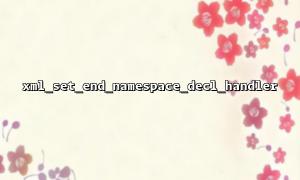In modern web applications, XML files are still commonly used for configuration, data exchange, and persistent storage. For frequently changed XML files, implementing a version control mechanism can greatly improve the reliability of data management. PHP provides a complete set of SAX-style XML parsing functions, where xml_set_end_namespace_decl_handler() allows us to perform callback processing at the end of the XML namespace declaration. This mechanism can be cleverly used to track XML structural changes, thereby achieving basic version control.
This function is used to set a callback function that is triggered when the parser parses to the end of a namespace declaration. This is useful when dealing with complex XML documents with multiple namespaces and also provides a structure-aware entry point for version control.
The function prototype is as follows:
bool xml_set_end_namespace_decl_handler(XMLParser $parser, callable $handler)
$parser : A parser resource created by xml_parser_create() .
$handler : A callback function that handles the end of the namespace.
In order to implement the version control function of XML files, we can use xml_set_end_namespace_decl_handler() to identify the namespace change, record each structure change, and save the corresponding version of the data.
Here are the key points to achieve:
Initialize the XML parser
Set the processing function for the start and end of the namespace
Record "version snapshot" at the structure change
Save snapshot data to versioned storage (such as database or file system)
<?php
$xmlData = file_get_contents('https://gitbox.net/xml/sample.xml');
$parser = xml_parser_create_ns("UTF-8", ":");
$versions = [];
$currentVersion = [];
$versionCount = 0;
// Processing function at the end of the namespace
function endNsHandler($parser, $prefix)
{
global $versionCount, $currentVersion, $versions;
// Record snapshots at the end of each namespace
$versionCount++;
$versions["version_$versionCount"] = $currentVersion;
$currentVersion = []; // Reset the current version data
}
// Processing element start event(Used to collect structural information)
function startElement($parser, $name, $attrs)
{
global $currentVersion;
$currentVersion[] = [
'element' => $name,
'attributes' => $attrs
];
}
// Setting up processing functions
xml_set_element_handler($parser, "startElement", null);
xml_set_end_namespace_decl_handler($parser, "endNsHandler");
// Analysis XML data
if (!xml_parse($parser, $xmlData, true)) {
die("XML Error: " . xml_error_string(xml_get_error_code($parser)));
}
// Output version information
foreach ($versions as $version => $data) {
echo "=== $version ===\n";
foreach ($data as $node) {
echo "Element: {$node['element']}, Attributes: " . json_encode($node['attributes']) . "\n";
}
}
xml_parser_free($parser);
?>
This structure-aware version control scheme can be widely used in:
Configuration file version backup and recovery
Conflict detection of multi-user collaborative editing of XML content
Automatic tracking of document format changes
By using xml_set_end_namespace_decl_handler() , PHP developers can perceively parse the XML file structure without using external libraries and implement basic version control logic. Although not as complex and complete as Git, it is sufficient to deal with requirements such as structural change recording and content recovery in many lightweight systems.
Do I need to help you with a version of the interface or database storage?
Related Tags:
XML














